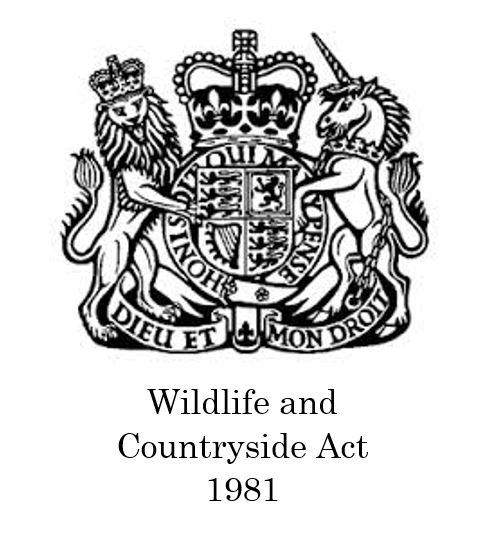Danniel Morley

The United Kingdom has a strong historical commitment to European environmental law, and the protection and conservation of wildlife and habitats. There have been numerous and environmental bills put through the U.K parliament to uphold European law, one of the most significant being The Wildlife and Countryside Act.
Key words: UK legislation, environmental law, conservation
REPORT
The Wildlife and Countryside Act of 1981 was a governmental bill passed through the U.K parliament on the 30th October 1981, its jurisdiction covering England, Scotland and Wales. Its main purpose was to comply and uphold with numerous European Union laws and conventions on conservation of wildlife and habitats, these include the Bern Convention on the Conservation of European Wildlife, the European Union Directives on the Conservation of Wild Birds and the Convention on the Conservation of Migratory Species of Wild Animals. All of these EU bills expected greater conservation of individual species at risk but also direct protection of the habitats to facilitate the conservation process.
The Act is the U.K government’s means by which they fulfil the quotas set out in the EU bills. The Act encompasses almost the entirety of U.K conservation legislation, it acts as a framework by which potential conservation bills are worked through. It does this by covering almost all areas of conservation, it is split in to 74 sections which fall in to 4 distinct categories. The first category being Wildlife, this category has the largest amount of sections in it, covering the most legislation. It focusses heavily on the protection of Bird species and breeding patterns, carrying on the work of the Bird Directive. This category also covers general protection of other animals and mammals, restricting certain methods of taking as with Birds, plant based legislation also falls under this category. The next category is Nature Conservation, Countryside and National Parks. This governs sites of Specific Scientific Interest and other important nature sites both on land and marine. Also covers agricultural works and agreements and the designation and maintenance of National Parks. The third category is the Public Rights of Way which entails defining and maintaining rights of way and managing signposting and other matters. The fourth category is simply Miscellaneous which includes less important sections such as applications to royal land and the isle of Sicily.
In terms of actual successful environmental governance, the Wildlife and Countryside Act is difficult to gauge as it means essentially assessing the governance of the whole U.K’s environmental legislation. There have been numerous conservation success stories that attest to the legislative success, an example like the Red Kite, which was on the brink of total extinction with only 10 breeding pairs at its lowest point but thanks to the now longest running conservation and reintroduction scheme their numbers have returned to the point of them being dubbed a pest in some urban areas. However despite reasonable success in conserving and governing the environment, the act has been called into question in its entirety, in 2011 the then Conservative government sought to overhaul the conservation law but mass resistance from the population and NGO’s meant that the overhauls were scrapped. The argument against the scrappage was that the Act has been successful at instilling a mind-set of conservation right down to the local level and also successful at establishing a political framework for conservation which is established in law making it strong and defined in its age, something that 20,000 people feared losing due to its success in governing the environment.
View presentation (PDF):
Wildlife and Countryside Act 1981 Daniel Morley
Works Cited:
- Ffrench, A. (2012). Oxford Mail; Once rare red kites ‘are becoming a pest’ [Online]Available at: http://www.oxfordmail.co.uk/news/9506531.Once_rare_red_kites__are_becoming_a_pest_/[Accessed 17 March 2016]
- JNCC (2015). The Wildlife and Countryside Act 1981 [Online] Available at: http://jncc.defra.gov.uk/page-1377 [Accessed 17 March 2016]
- naturenet.net (2016). Wildlife and Countryside Act 1981; Species Protection [Online] Available at: http://naturenet.net/law/wcagen.html [Accessed 17 March 2016]
- Portugal, S. (2016). Birds of Britain; Conservation Success Stories [Online] Available at: http://birdsofbritain.co.uk/features/conservation.asp [Accessed 17 March 2016]
- RSPB (2011). Conservation [Online] Available at: http://www.rspb.org.uk/discoverandenjoynature/discoverandlearn/birdguide/name/r/redkite/conservation.aspx [Accessed 17 March 2016]
- Vidal, J. (2015). The Guardian; UK criticised for failure to defend European nature protection laws [Online] Available at: http://www.theguardian.com/environment/2015/oct/28/uk-criticised-for-failure-to-defend-european-nature-protection-laws [Accessed 17 March 2016]
- Wildlife and Countryside Act (1981[a]). Joint Nature Conservation Committee [Online]Available at: http://jncc.defra.gov.uk/page-3614 [Accessed 17 March 2016]
- Wildlife and Countryside Act (1981[b]). Chapter 69 [Online] Available at: http://www.legislation.gov.uk/ukpga/1981/69 [Accessed 17 March 2016]